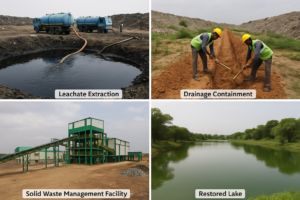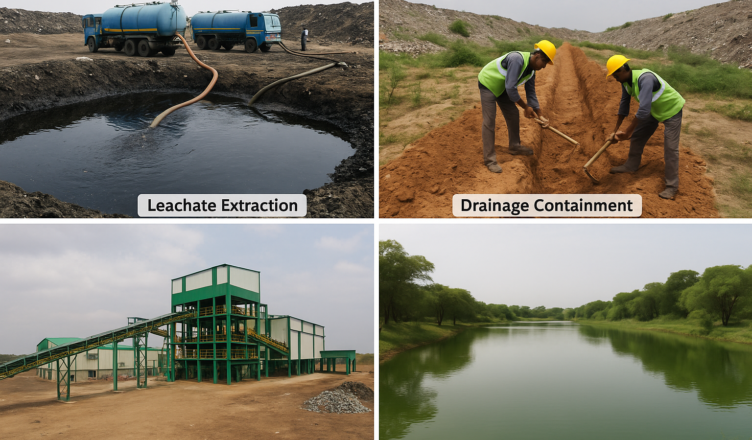Originally part of the Aravalli hill ecosystem, the Bhandwari landfill sits adjacent to water bodies that act as seasonal ponds. Over time, untreated leachate from the landfill seeped into these ponds—contaminating groundwater, harming flora and fauna, and posing health hazards to nearby forest land and wildlife.
The problem escalated to the extent that animals in the Aravalli forests were reportedly drinking from these toxic reservoirs.
✅ Restoration Actions Underway
1. Leachate Extraction & Treatment
-
Tanker-based removal: The Municipal Corporation of Gurugram (MCG) has begun pumping legacy leachate from the landfill’s ponds into tankers.
-
STP discharge: These tankers transport leachate to the Behrampur and Dhanwapur sewage treatment plants—each with over 400 MLD capacity—for safe treatment before discharge.
MCG aims to empty the polluted ponds before the monsoon and plans additional infrastructure to halt leachate infiltration into adjacent forests.

2. Drainage Containment
A dedicated drainage network is being constructed around the landfill to prevent future leaks. This includes:
-
Trenching systems
-
Bund formations
-
Strategic redirection of surface water
These efforts are designed to contain current contamination and block further spread into groundwater and forest areas .
3. Solid Waste Management Upgrade
The Bhandwari solid waste management facility is being revived under a public-private partnership from 2017–2019, with backing from Ecogreen Energy Pvt Ltd. The ₹4.3 billion project includes:
-
Daily handling of 1,250 TPD of waste
-
Processing via refuse-derived fuel (RDF)
-
Generation of ~10 MW of energy per day
This redevelopment is key to reducing landfill size and subsequent contamination.
🦺 Local & Ecological Importance
-
Forest protection: These ponds are located in the Aravalli buffer zone, home to diverse wildlife. Clearing leachate helps restore ecological balance.
-
Public health: Reducing groundwater pollution is vital for nearby human populations—especially as toxic leachate seepage can render water unsafe.
-
Environmental compliance: Prompted by local activism, the initiative aligns with legally binding obligations to preserve forest ecosystems.
🚧 Challenges & What Lies Ahead
| Challenge | Description |
|---|---|
| Speed vs. scale | The quantity of leachate is large; clearing it before the monsoon demands logistical precision. |
| Long-term prevention | Beyond emergency pumping, long-term solutions like engineered liners and continuous monitoring are needed. |
| Governance coordination | Integrating MCG, Haryana Govt, STPs, and private partners requires strong oversight. |
| Community engagement | Ensuring transparency, updates, and public reassurance is crucial. |
🌱 Restoration Roadmap – What Next
-
Advanced lining and cap systems for the landfill to halt future leachate generation.
-
Routine environmental monitoring of water quality and wildlife health.
-
Engineering wetlands or bio-treatment zones to naturally manage minor seepage.
-
Waste diversion strategies—such as composting and recycling—to minimize landfill input.
-
Community stewardship and educational outreach to maintain vigilance and awareness.
✅ Conclusion
The Bhandwari Lake restoration is a vital environmental intervention. From actively removing hazardous leachate and bolstering drainage infrastructure to revamping waste management operations, the success of this initiative will directly protect the Aravalli forests, groundwater reserves, and regional ecosystems.
But this must be more than a short-term fix. A forward-thinking, sustainable strategy involving engineering safeguards, community participation, and pollution prevention is essential to ensure the landfill doesn’t turn into a recurring ecological threat.
📣 How You Can Contribute
-
Stay informed through MCG and Haryana government disclosures.
-
Join or support local environmental groups monitoring forest and water health.
-
Encourage practices like waste segregation and composting to reduce landfill waste.
-
Advocate for robust engineering solutions—like geomembrane liners—at municipal and civic forums.
Together, Gurugram can set a benchmark for landfill rehabilitation and natural resource restoration in urban India.
For more such articles, please visit ecodastkaari.com.

